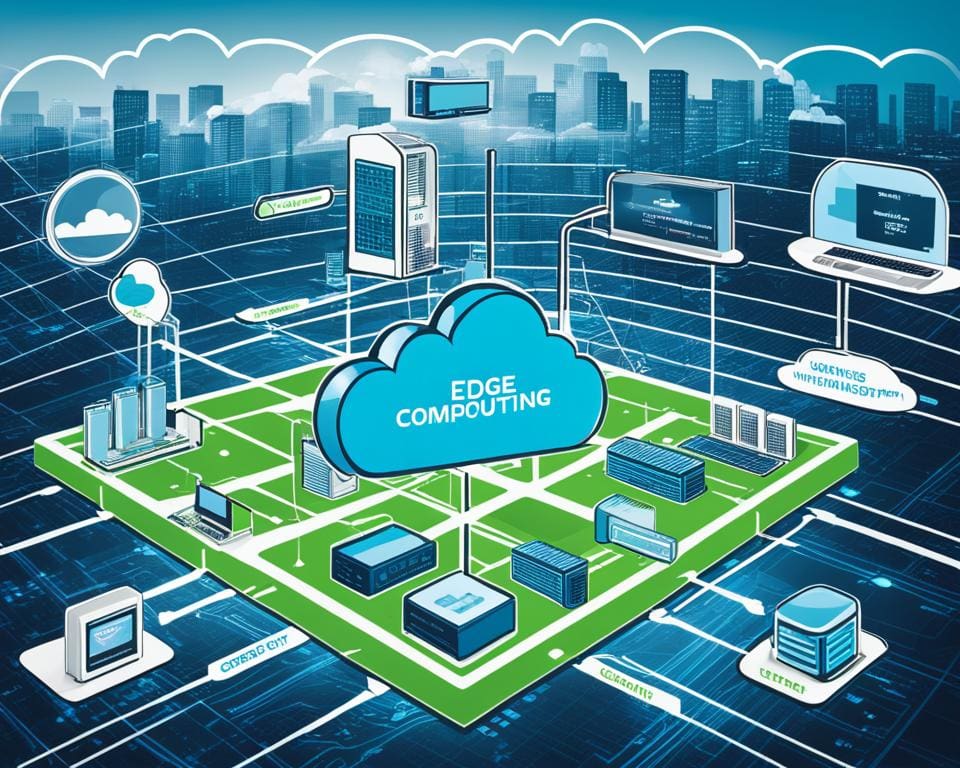We are entering a new era with edge computing and IoT. The growth of connected devices makes learning about edge computing essential. It speeds up data processing by doing it closer to where data is made. This means faster response times and smarter decisions. Gartner says by 2025, most of our data will be dealt with at the edge, not in data centers.
Edge computing offers big benefits. It makes networks faster, more reliable, and secure. It also cuts costs. Industries like smart cities and healthcare can do more, thanks to edge computing. Let’s look closer at how edge computing changes things, where time and details are key.
Understanding Edge Computing and Its Role in IoT
Businesses are seeing how crucial edge computing is as they need real-time data processing. This approach moves data processing close to where it’s created. By doing this, devices compute fast without leaning on far-off cloud servers. It’s key to grasp this change, especially with IoT (Internet of Things) technologies in mind.
Definition of Edge Computing
Edge computing puts computing tasks nearer to data sources, on the network’s edge. By processing data locally, devices respond quicker. This method lowers delay in tech like self-driving cars and factory automation. Proximity means companies manage resources well and improve data safety by cutting transmission risks.
Distinction from Cloud Computing
Edge and cloud computing share traits, yet differ significantly. Cloud computing gathers data in central servers, which can slow things down. Edge computing, however, lets devices process data right where it is. This boosts reliability and improves performance. Despite its promise, only 27% of companies fully use edge computing, though 54% see its value. Gartner suggests by 2025, most company data will come from outside traditional centers, showing localized processing’s importance.

Exploring the Potential of Edge Computing in IoT
Edge computing is key to boosting the Internet of Things (IoT), bringing big benefits across different fields. It makes operations smoother, increases efficiency, and sparks new ideas.
Benefits of Edge Computing
Reducing latency is a major advantage of edge computing. This is especially important in the automotive area, helping safety features work better. It helps with real-time processing, improving safety and happiness for users.
Edge computing makes better use of bandwidth by handling data locally. In healthcare, this means faster alerts for doctors during emergencies. This not only saves money but also makes things run more smoothly.
Reliability gets a boost since edge computing lessens the risk of system failures. Edge devices can work on their own, offering steady performance. For example, automotive businesses use edge computing for AI driving and driver-help systems.
Security and privacy also improve with edge computing, by dealing with sensitive data nearer its source. As the retail and manufacturing fields use it for things like store analytics and fix-before-fail services, security matters more and more.
Edge computing makes dealing with data sync and management easier. Various industries, from transport to entertainment, use edge computing. This lets them offer instant services, staying ahead in the fast-changing market.
Key Applications of Edge Computing in IoT
Edge computing is changing how IoT devices at the edge work. It is bringing new applications in many fields. Retail, healthcare, and transportation are seeing big changes. This technology boosts performance and helps make better decisions.
In retail, long lines cost about $37.7 billion in lost sales every year. Edge computing helps fix this by making shopping smoother and managing stock better. It processes data fast at the edge. This helps cut down wait times and boosts service. It’s key for staying ahead in a fast market.
Healthcare is also gaining from edge computing. More surgeries are now done with robot help. This makes surgery less invasive and more precise. Edge computing gives surgeons data in real time. This leads to better results and more comfort during operations. It’s a big step forward for patient care and how hospitals work.
In critical situations like self-driving operations and sales systems, looking into edge computing’s role in IoT is vital for quick decisions. It lets businesses keep running smoothly, even if the cloud fails. Processing data locally is good for privacy, like with private health information.
Combining edge computing with AI and machine learning offers deep insights at the device level. Federated learning boosts privacy by letting devices work together without sharing all their data. Digital twins help businesses understand and watch over their physical assets better. This tech brings many benefits.
To wrap it up, edge computing is reshaping how industries handle tasks and react to data now. By using IoT devices at the edge, companies get more efficient. They also become quicker to react, meeting today’s needs better.
Challenges and Future Directions in Edge Computing
As edge computing grows, organizations face many challenges. Deploying hardware in different places increases costs and needs good management. Security is also a big issue, especially where data is stored locally and could be easily breached without strong protection.
Future improvements in IoT and edge computing rely on innovators and researchers. They aim to make data storage safer and improve hardware for better apps. Multi-Access Edge Computing (MEC) could fix current issues while boosting the benefits of edge computing.
The edge computing market is booming, expecting to grow 37.9% yearly until 2030. As it grows, focusing on green and ethical data practices is essential. By tackling data privacy and bias, we can make edge computing fairer. This approach lets organizations use edge computing to its full potential while being responsible.









